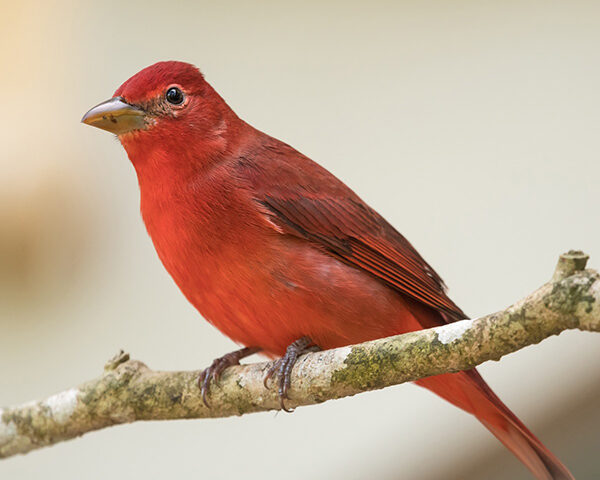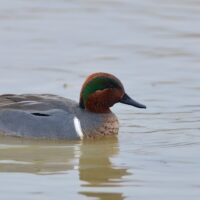The summer tanager (Piranga rubra) is a secretive songbird of the treetops.
It was first described in the scientific literature by Swedish naturalist Carl Linnaeus in 1758 and initially placed in the Tanager family (Thraupidae). It is now classified in the Cardinal family (Cardinalidae) because its plumage and vocalizations are similar to other members of the Cardinal family.

There are two subspecies.
In the southeastern U.S. its most common summer breeding range extends from Virginia, south to northern Florida, west to Texas, north to Missouri, southern Illinois, Indiana, and Ohio through Kentucky into western West Virginia.
This summer resident is a native species that breeds throughout Kentucky, living in forested habitats, most preferably upland oak-hickory forests. Seeing one may require some patience since this bird moves rather slowly in the treetops, often remaining hidden among the leaves.
Size and coloration
The summer tanager is a medium-size songbird, standing about 7 inches tall, weighing about 1.5 ounces, with a wingspan of about 11.5 inches.

Adults have stout, pointed bills, rounded wings and square-tipped tails.
Adult males are a bright rosy red all year, but young males may be patchy yellowish and red. Adult females are orangish on the underparts and olive on top, with olive-brown wings and tail.
Their songs are similar to the American Robin, but softer, with three to four melodic units, repeated in a constant stream. When the bird is agitated it may utter a sharp call: “pi-tuk or pik-i-tuk-i-tuk.”
Food habits and diet
The summer tanager forages mainly in the tops of trees, moving rather deliberately, pausing to look around.
Makes short flights to capture flying insects in mid-air, or hover momentarily while picking them from branches or foliage.
They eat mostly insects, including beetles, cicadas, caterpillars, grasshoppers, flies, and some spiders.
They are a predator of stinging bees and wasps, and will break into wasp nests to eat the larvae inside.
At times, they also feed on small fruits and berries, especially while on their wintering grounds.
Courtship and nesting
The wintering range is surprisingly extensive, from central Mexico to Bolivia and Brazil. They migrate north and south on a broad front, with some crossing Gulf of Mexico and others traveling overland.

According to The Kentucky Breeding Bird Atlas, summer tanagers “return from their wintering grounds the last two weeks of April, and nesting activities begin at once… early clutches are completed by the first week of May, peaking the last 10 days of the month.”
Some pairs raise two clutches, nesting into July.
The male sings to defend their nesting territory. In early stages of courtship, males frequently chase females.
The nest site is in a tree, placed on a horizontal branch, usually well out from trunk, 10 to 35 feet above the ground. The nest is a loosely made shallow cup of grass, weed stems, bark strips, leaves, and spiderwebs, built by the female.
She lays three to five pale green or blue-green, with brown and gray spots sometimes concentrated at larger end of the eggs. Incubation by the female lasts 11 to 12 days. Both parents feed the nestlings.
The summer tanager is not easily observed, but keep looking for this bright red jewel of the green treetops.
This article is republished with permission from the Northern Kentucky Tribune. Read the original.
Art Lander Jr. is outdoors editor for the Northern Kentucky Tribune. He is a native Kentuckian, a graduate of Western Kentucky University and a lifelong hunter, angler, gardener and nature enthusiast. He has worked as a newspaper columnist, magazine journalist and author and is a former staff writer for Kentucky Afield Magazine, editor of the annual Kentucky Hunting & Trapping Guide and Kentucky Spring Hunting Guide, and co-writer of the Kentucky Afield Outdoors newspaper column.






